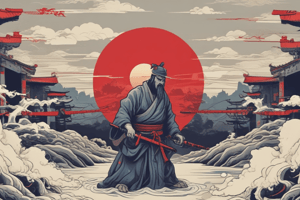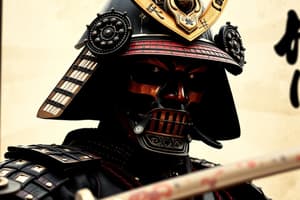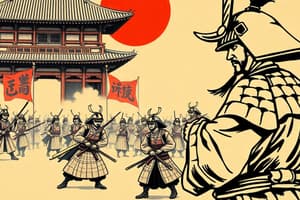Podcast
Questions and Answers
What is the name of the Over-Hand Outward Block in karate?
What is the name of the Over-Hand Outward Block in karate?
- Haisho Sotouke (correct)
- Haisho Kakiwakeuke
- Haishuuke
- Shutouke
Which type of block is used to scoop the opponent's attack?
Which type of block is used to scoop the opponent's attack?
- Otoshiuke
- Kokenuke
- Hijiuke
- Sukuiuke (correct)
What is the name of the Knife-Hand Block in karate?
What is the name of the Knife-Hand Block in karate?
- Shutouke (correct)
- Kokenuke
- Haishuuke
- Hijiuke
What is the term for the Referee in competition karate?
What is the term for the Referee in competition karate?
What is the color of the competitor's belt in competition karate?
What is the color of the competitor's belt in competition karate?
What is the term for 'Stop' or 'End of the Bout' in competition karate?
What is the term for 'Stop' or 'End of the Bout' in competition karate?
What is the term for 'Original Position' in competition karate?
What is the term for 'Original Position' in competition karate?
What is the term for 'Fight on' or 'Resume Fighting' in competition karate?
What is the term for 'Fight on' or 'Resume Fighting' in competition karate?
What is the name of the Foot sole Round Block in karate?
What is the name of the Foot sole Round Block in karate?
What is the term for the Judge in competition karate?
What is the term for the Judge in competition karate?
Flashcards are hidden until you start studying
Study Notes
Karate Ni Sente Nashi
- Karate Ni Sente Nashi is a fundamental concept in karate that means "never attack first" mentally or physically.
- It emphasizes the importance of correct training and etiquette in karate.
Shinitai
- Shinitai means "dead body" and refers to the ability to recover quickly and easily from being thrown or attacked.
- It involves maintaining a position that allows for quick recovery and movement.
Kime
- Kime refers to the focusing of physical and psychological forces at one point for maximum effectiveness.
- It is a key concept in karate training.
Bunkai
- Bunkai refers to the ability to explain and demonstrate the application of karate moves in real-life situations.
- It involves understanding the practical application of karate techniques.
Otagai Ne Rei
- Otagai Ne Rei is a request from students to each other for help, respect, and seriousness in training.
- It also helps to prevent trouble between students while training.
Bows in Karate
- There are two types of bows in karate: Zarei (kneeling bow) and Ritsurei (standing bow).
- Zarei is performed by placing hands on thighs, dropping them to the floor, and moving them to the front of the body with thumbs and index fingers touching.
- In a standing bow, hands can be placed either side of the legs or in front of the thighs.
Three Patterns of Attack Initiative
- Sen Sen No Sen: Attack when both opponents are ready and willing to attack.
- Sen: Attack simultaneously with the opponent, focusing on beating them to the punch.
- Go No Sen: Remain calm and wait for the opponent to attack, then block and counterattack.
Special Distinctions of Wado Ryu
- Nagas: Brushing techniques
- Inas: Feinting techniques
- Kawas: Dodging techniques
- Noru: Anticipation, counter techniques
- Toru: Holding, throwing, and sweeping techniques
Tachikata (Stances Used in Karate)
- Shizentai (Natural Stances): Heisokudachi, Masubidachi, Heikodachi, Hachijidachi, and Renjidachi
- Uneven Stances: ZENKUTSUDACHI (Front Stance) and KOKUTSUDACHI (Back Stance)
Methods of Attacking Vital Points
- Vital points are areas on the body that are difficult to develop and can cause severe pain, loss of consciousness, or even death when attacked.
- Attacking vital points involves using techniques to target specific areas of the body, such as the centre of the skull, temples, bridge of the nose, and under the nose.
Competition Karate Terminology
- FUKUSHIN: Judge
- SHUSHIN: Referee
- KANSA: Arbitrator
- AO: Blue
- AKA: Red
- SHOBU HAJIME: Start the match or bout
- ATOSHI BARAKU: A little more time left
- YAME: Stop
- MOTO NO ICHI: Original position
- TSUZUKETE: Fight on
Studying That Suits You
Use AI to generate personalized quizzes and flashcards to suit your learning preferences.




